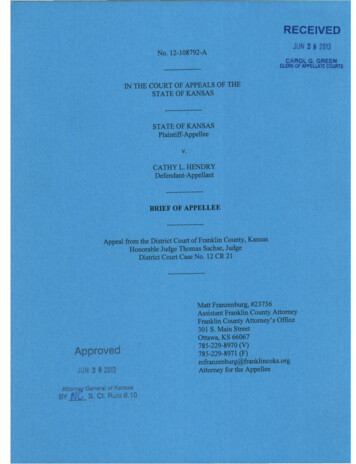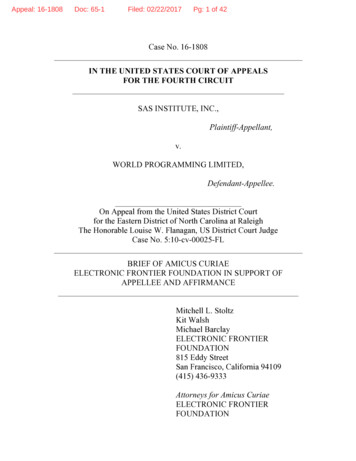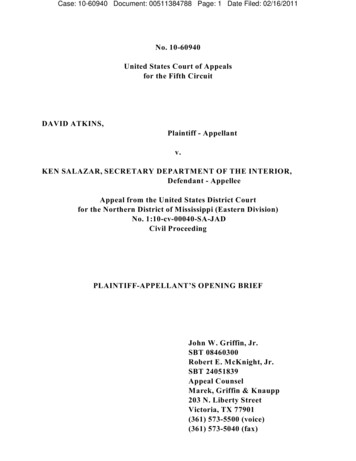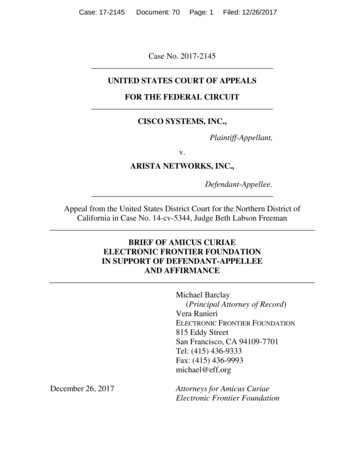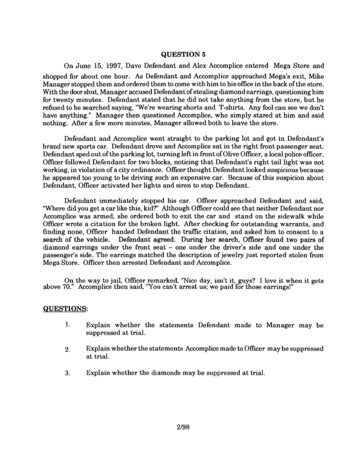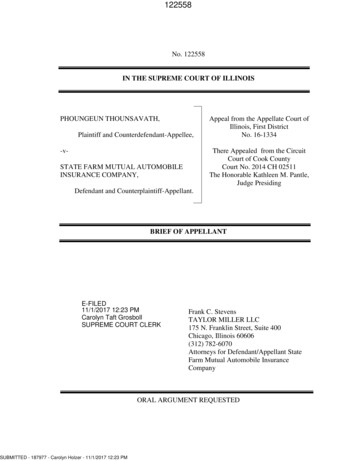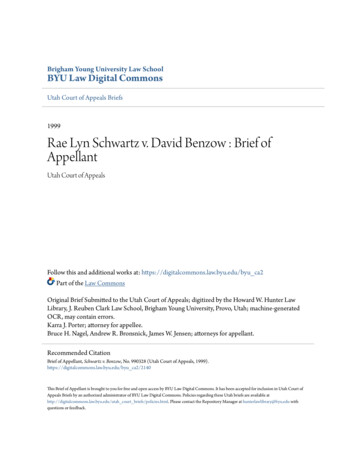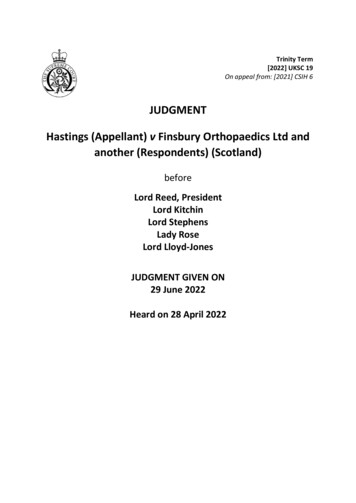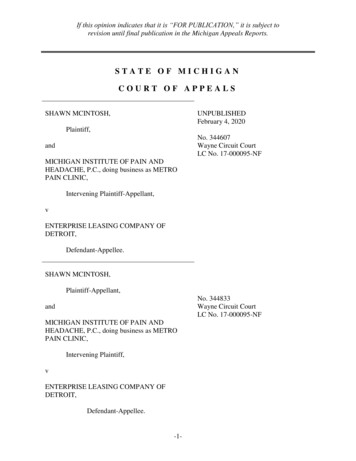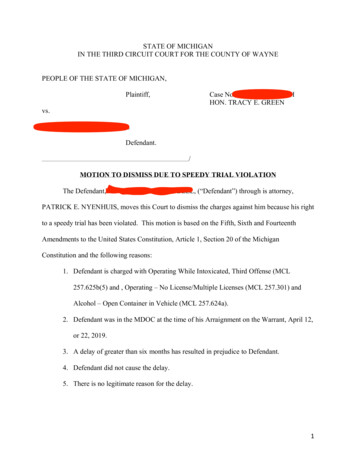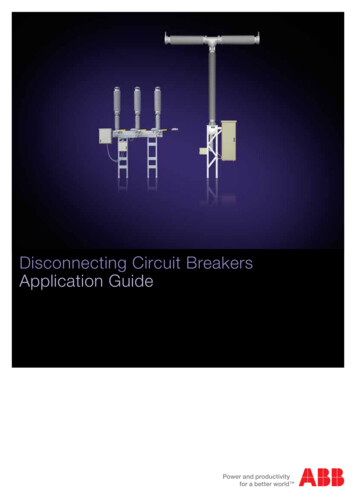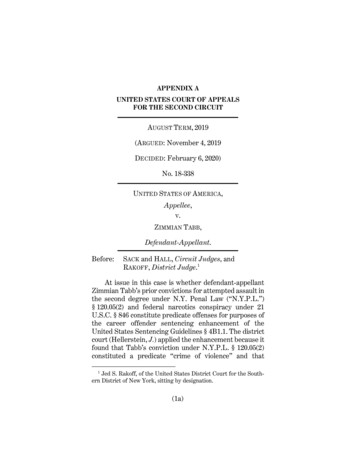
Transcription
APPENDIX AUNITED STATES COURT OF APPEALSFOR THE SECOND CIRCUITAUGUST TERM, 2019(ARGUED: November 4, 2019DECIDED: February 6, 2020)No. 18-338UNITED STATES OF AMERICA,Appellee,v.ZIMMIAN TABB,Defendant-Appellant.Before:SACK and HALL, Circuit Judges, andRAKOFF, District Judge.1At issue in this case is whether defendant‐appellantZimmian Tabb’s prior convictions for attempted assault inthe second degree under N.Y. Penal Law (“N.Y.P.L.”)§ 120.05(2) and federal narcotics conspiracy under 21U.S.C. § 846 constitute predicate offenses for purposes ofthe career offender sentencing enhancement of theUnited States Sentencing Guidelines § 4B1.1. The districtcourt (Hellerstein, J.) applied the enhancement because itfound that Tabb’s conviction under N.Y.P.L. § 120.05(2)constituted a predicate “crime of violence” and thatJed S. Rakoff, of the United States District Court for the Southern District of New York, sitting by designation.1(1a)
2aTabb’s conviction under 21 U.S.C. § 846 constituted apredicate “controlled substance offense.” The Courtagrees with both findings. Accordingly, application of thecareer offender sentencing enhancement was appropriateand the judgment of the district court is AFFIRMED.FOR APPELLEE: WON S. SHIN, Assistant UnitedStates Attorney (Geoffrey S. Berman, United States Attorney for the Southern District of New York, David W.Denton, Jr., Rebekah Donaleski, Assistant United StatesAttorneys, on the brief), New York, NYFOR DEFENDANT-APPELLANT: RICHARD E.SIGNORELLI, Law Office of Richard E. Signorelli, NewYork, NYRAKOFF, District Judge:Zimmian Tabb appeals from a judgment of convictionentered on January 25, 2018 and a Sentencing Order entered on January 26, 2018 in the United States DistrictCourt for the Southern District of New York (Hellerstein,J.). Tabb contends that he was improperly classified as acareer offender based on his prior convictions for attempted assault in the second degree under N.Y. PenalLaw (“N.Y.P.L.”) § 120.05(2) and federal narcotics conspiracy under 21 U.S.C. § 846. Because we agree that bothcrimes constitute predicate offenses for purposes of thecareer offender sentencing enhancement of the UnitedStates Sentencing Guidelines (“U.S.S.G.”) § 4B1.1, we affirm the judgment of the district court.I.FactsOn May 5, 2017, Tabb pled guilty to aiding and abetting the distribution of 3.75 grams of crack cocaine, in violation of 21 U.S.C. § 841(b)(1)(C) and 18 U.S.C. § 2. Theplea agreement did not stipulate whether Tabb’s prior
3aconvictions qualified him for the career offender enhancement of U.S.S.G. § 4B1.1. Under U.S.S.G. § 4B1.1, a defendant is a career offender if (1) he is over 18; (2) the present offense is a felony crime of violence or a controlledsubstance offense; and (3) he “has at least two prior felonyconvictions of either a crime of violence or a controlledsubstance offense.” U.S.S.G. § 4B1.2 sets out the definitions of both a “crime of violence” and a “controlled substance offense.”At sentencing, the district court concluded that Tabbhad two prior felony convictions for purposes of the sentencing enhancement. First, Tabb’s 2014 conviction forconspiracy to distribute and possess with intent to distribute crack cocaine in violation of 21 U.S.C. § 846 constituted a predicate controlled substance offense. Second,Tabb’s 2010 conviction for attempted assault in the seconddegree in violation of N.Y. Penal Law (“N.Y.P.L.”)§ 120.05(2) constituted a predicate crime of violence.Based on these prior convictions, the district courtconcluded that Tabb qualified for the career offender enhancement and calculated his Guidelines range to be 151to 188 months’ imprisonment. Without the career offender enhancement, Tabb’s Guidelines range would havebeen 33 to 41 months.2 Ultimately, the district court imposed a below-guidelines sentence of 120 months. Tabbappeals the judgment and sentencing order on the groundthat he should not have been classified as a career offender. This Court reviews de novo a district court’s interpretation of the Guidelines. United States v. Matthews,205 F.3d 544, 545 (2d Cir. 2000).As this illustrates, the career offender enhancement often dwarfsall other Guidelines calculations and recommends the imposition ofsevere, even Draconian, penalties.2
4aII. AnalysisTabb argues that he should not have been classifiedas a career offender under U.S.S.G. § 4B1.1 because hedid not have two predicate convictions. First, he arguesthat attempted assault in the second degree under N.Y.Penal Law § 120.05(2) is not a predicate conviction because it is not crime of violence within the relevant provision of U.S.S.G. § 4B1.2 (known as the “Force Clause”).Second, he argues that his narcotics conspiracy convictionunder 21 U.S.C. § 846 is not a predicate conviction becauseit does not qualify as a controlled substance offense. Neither argument is persuasive.A. Tabb’s Conviction for Attempted Assault in theSecond Degree (N.Y.P.L § 120.05(2))Tabb first argues that attempted assault in the second degree under N.Y.P.L § 120.05(2) is not a crime of violence under the Force Clause of § 4B1.2. A person isguilty of second-degree assault under N.Y.P.L.§ 120.05(2) when, “[w]ith intent to cause physical injury toanother person, he causes such injury to such person or toa third person by means of a deadly weapon or a dangerous instrument.” This qualifies as a “crime of violence” under the Force Clause (also sometimes referred to as the“Elements Clause”) if it “has as an element the use, attempted use, or threatened use of physical force againstthe person of another.” U.S.S.G. § 4B1.2.3A crime can also qualify as a “crime of violence” if it meets thesentencing guidelines’ “enumerated offenses clause,” or “is a murder,voluntary manslaughter, kidnapping, aggravated assault, a forciblesex offense, robbery, arson, extortion, or the use or unlawful possession of a firearm described in 26 U.S.C. § 5845(a) or explosive materialas defined in 18 U.S.C. § 841(c).” Because attempted assault in thesecond degree under N.Y.P.L. §120.05(2) qualifies as a crime of violence under the Force Clause, we need not determine whether it3
5aU.S.S.G. § 4B1.2’s Force Clause is identical to language in two other statutes: the definition of “violent felony” under the Armed Career Criminal Act (“ACCA”),and the definition of “crime of violence” under 18 U.S.C.§ 16(a). “[T]he identical language of the elements clausesof 18 U.S.C. § 16(a) and [ACCA] means that cases interpreting the clause in one statute are highly persuasive ininterpreting the other statute,” as well as in interpretingU.S.S.G. § 4B1.2. Stuckey v. United States, 878 F.3d 62,68 n.9 (2d Cir. 2017), cert. denied, 139 S. Ct. 161 (2018).Thus, in evaluating Tabb’s claim, this Court is guided byits ACCA and § 16(a) jurisprudence.Tabb first argues that attempted assault in the second degree under N.Y. Penal Law § 120.05(2) cannot be acrime of violence because the substantive crime of seconddegree assault is not itself a crime of violence. To determine whether a state crime falls under the SentencingGuidelines, the Second Circuit generally uses the “categorical approach” prescribed by the Supreme Court. Taylor v. United States, 495 U.S. 575, 600 (1990). Under thisabstract approach, a court considers the “generic, contemporary meaning” of the crime in the guidelines, id. at598, and then determines whether the crime committedby the defendant falls under this “generic offense.” TheCourt “ignores the circumstances of the particular defendant’s crime and asks instead what is the minimumcriminal conduct necessary to sustain a conviction underthe relevant statute.” Singh v. Barr, 939 F.3d 457, 462 (2dCir. 2019) (internal quotation marks and citation omitted).“[O]nly if the statute’s elements are the same as, or narrower than, those of the generic offense does the priorconviction serve as a predicate offense for a sentencingenhancement.” United States v. Castillo, 896 F.3d 141,would also meet the enumerated offenses clause definition of a crimeof violence.
6a149-50 (2d Cir. 2018) (internal quotation marks and citation omitted).Tabb’s argument that N.Y.P.L. § 120.05(2) is not acrime of violence under the categorical approach is severely undercut by this Court’s holdings from the ACCAand § 16(a) contexts. In United States v. Walker, 442 F.3d787 (2d Cir. 2006) (per curiam), this Court held that attempted assault in the second degree N.Y.P.L. § 120.05(2)is “categorically” a violent felony under ACCA because“[t]o (attempt to) cause physical injury by means of adeadly weapon or dangerous instrument is necessarily to(attempt to) use ‘physical force,’ on any reasonable interpretation of that term.” Id. at 788. More recently, in Singhv. Barr, 939 F.3d 457 (2d Cir. 2019) (per curiam), theCourt reaffirmed Walker’s holding and held that the substantive crime of second-degree assault under N.Y.P.L.§ 120.05(2) is also categorically a crime of violence under§ 16(a)’s Force Clause. Thus, this Court has found that thesubstantive crime of N.Y.P.L. § 120.05(2) categorically“has as an element the use, attempted use or threateneduse of physical force against the person of another” underboth ACCA and § 16(a).Tabb provides no reason why the result should be different under U.S.S.G. § 4B1.2. Indeed, Tabb largely relieson cases from both the ACCA and § 16(a) context to arguethat second-degree assault under N.Y.P.L. § 120.05(2) isnot a crime of violence. For example, Tabb relies on anearlier § 16(a) case, Chrzanoski v. Ashcroft, 327 F.3d 188(2d Cir. 2003), to argue that second-degree assault doesnot qualify as a crime of violence because it may be accomplished by indirect force. Singh, however, necessarily, andexplicitly, rejected this argument when it found that second-degree assault under N.Y.P.L. § 120.05(2) was acrime of violence under § 16(a). 939 F.3d at 463 (“[I]ndirect methods of inflicting serious physical injury still meetthe physical force requirement of § 16(a).”). Moreover, the
7aview of “force” set forth in Chrzanoski was subsequentlymodified by our Court in light of the Supreme Court decision in United States v. Castleman, which held that physical force in the context of a misdemeanor crime of domestic violence “encompasses even its indirect application.”Villanueva v. United States, 893 F.3d 123, 130 (2d Cir.2018) (quoting Castleman, 572 U.S. 157, 170 (2014)); seealso United States v. Hill, 890 F.3d 51, 60 (2d Cir. 2018)(recognizing the Chrzanoski court “did not have the benefit of the Supreme Court’s reasoning in Castleman”).Tabb’s alternative Chrzanoski-based argument—that second-degree assault under N.Y.P.L. § 120.05(2) isnot categorically a crime of violence because it can be committed by omission—is no more successful. In Singh, theCourt requested supplemental briefing on “whetherNYPL § 120.05(2) allows for the imposition of liabilitybased on a defendant’s omission to act.” Singh, 939 F.3dat 463. Neither the parties nor the panel were able to finda single example of such liability being imposed. Id. Indeed, the panel explained that “it is nearly impossible toconceive of a scenario in which a person could knowinglyor intentionally injure, or attempt to injure, another person with a deadly weapon without engaging in at leastsome affirmative, forceful conduct.” Id. at 463-64 (quotingUnited States v. Ramos, 892 F.3d 599, 612 (3d Cir. 2018)).Thus, notwithstanding Tabb’s objections, we find that thesubstantive crime of second degree assault underN.Y.P.L. § 120.05(2) “has as an element the use, attempted use or threatened use of physical force againstthe person of another” and is categorically a crime of violence under U.S.S.G. § 4B1.2.We next examine whether attempted second degreeassault under N.Y.P.L. § 120.05(2) may nonetheless notcategorically be a crime of violence. We reject this possibility. Walker, although an ACCA case, squarely held thatattempted second-degree assault under N.Y.P.L.
8a§ 120.05(2) requires the attempted use of physical force“on any reasonable interpretation of that term.” 442 F.3dat 788. This essentially precludes finding that New Yorkattempted second-degree assault does not have “as an element the . . . attempted use . . . of physical force againstthe person of another” under U.S.S.G. § 4B1.2.Recognizing that application of Walker’s holdingwould negate his argument, Tabb offers a number of reasons why it is not controlling here. None is persuasive.Tabb first argues that Walker is not controlling becausethe Walker Court did not discuss the statutory definitionof “dangerous instrument,” which can include substancesthat can cause death or physical injury without the use ofany force. As discussed above, however, the SupremeCourt has rejected the notion that the use of poison or another indirect application of force does not involve the useof physical force, see Castleman, 134 S. Ct. at 1414, andthe Second Circuit has recognized and adopted this holding in multiple statutory contexts. See Villanueva, 893F.3d at 128-29 (ACCA); Hill, 890 F.3d at 59-60 (18 U.S.C.§ 924(c)(3)(A)).Tabb next argues that an intervening Supreme Courtcase, Johnson v. United States, 559 U.S. 133 (2010), effectively abrogated Walker. In Johnson, the Supreme Courtclarified that “physical force” means “violent force—thatis, force capable of causing physical pain or injury to another person.” Id. at 140. However, Walker held that attempted assault in the second degree necessarily involvesan attempt to use such physical force “on any reasonableinterpretation of that term.” Walker, 442 F.3d at 788. Forthis reason, this Court has already rejected, albeit in anunpublished opinion, the notion that Johnson abrogatedWalker. See Brunstorff v. United States, 754 F. App’x 48,50 (2d Cir.), cert. denied, 140 S. Ct. 254 (2019). We agree.
9aFinally, Tabb argues that Walker is not controllingbecause “attempt” under New York law is broader thanthe generic “attempt” described in the guidelines. Thus,Tabb argues, a defendant could be convicted of attemptedassault in the second degree in New York without ever“attempt[ing]” to use physical force in the sense definedin the sentencing guidelines.4The elements of New York attempt, however, are nobroader than generic attempt. The Second Circuit hasfound that generic attempt is “the presence of criminal intent and the completion of a substantial step toward committing the crime.” Sui v. INS, 250 F.3d 105, 115 (2d Cir.2001). New York attempt requires intent to commit thecrime and an “action taken by an accused [] ‘so near [thecrime’s] accomplishment that in all reasonable probabilitythe crime itself would have been committed.’” UnitedStates v. Pereira-Gomez, 903 F.3d 155, 166 (2d Cir. 2018)(quoting People v. Mahboubian, 74 NY.2d 174, 196(1989)). The Second Circuit has held that this latter element of New York attempt “categorically requires that aperson take a ‘substantial step’ toward the use of physicalforce.” United States v. Thrower, 914 F.3d 770, 777 (2dCir. 2019) (per curiam).5 Thus, the elements of New Yorkattempt are the same as or narrower than generic attempt, and attempted assault in the second degree underAlthough this argument is essentially a veiled request to overruleWalker, we nonetheless address and thereby reaffirm Walker’s holding and clarify its scope.4Tabb’s citation to People v. Naradzay, 11 N.Y.3d 460 (2008), inwhich an individual was convicted of attempted murder without everhaving been in the presence of his victims, does not change this outcome. Someone can take a “substantial step” towards using forceagainst a victim even if that victim is not physically present at thatmoment, for example by “load[ing] a firearm and then start[ing] towards the person to be assailed.” People v. Sullivan, 173 N.Y. 122,136 (1903).5
10aNew York law categorically involves the “attempted use of physical force” under U.S.S.G. § 4B1.2.For the foregoing reasons, we find that attempted assault in the second degree under N.Y.P.L. § 120.05(2) iscategorically a crime of violence under the Force Clauseof U.S.S.G. § 4B1.2. Tabb’s conviction under this statutethus properly served as a predicate for his sentencing enhancement.B. Tabb’s Conviction for Narcotics ConspiracyUnder 21 U.S.C. § 846Tabb also argues that his conviction for conspiracy todistribute and possess with intent to distribute crack cocaine in violation of 21 U.S.C. § 846 (“Section 846”) cannotqualify as a predicate “controlled substance offense” under U.S.S.G. § 4B1.1. As defined in U.S.S.G. § 4B1.2, acontrolled substance offense is:an offense under federal or state law, punishable by imprisonment for a term exceeding oneyear, that prohibits the manufacture, import,export, distribution, or dispensing of a controlled substance (or a counterfeit substance)or the possession of a controlled substance (ora counterfeit substance) with intent to manufacture, import, export, distribute, or dispense.Application Note 1 of the commentary clarifies thatcontrolled substance offenses “include the offenses of aiding and abetting, conspiring, and attempting to commitsuch offenses.” U.S.S.G. § 4B1.2 cmt. n.1. The plain text ofU.S.S.G. § 4B1.2 as interpreted by Application Note 1thus appears to include narcotics conspiracies such as 21U.S.C. § 846. Tabb nonetheless argues that narcotics conspiracy under Section 846 is not encompassed by this definition, and is thus not a proper predicate for a sentencingenhancement.
11aTabb first argues that narcotics conspiracy under 21U.S.C. § 846 is not a proper predicate conviction becauseApplication Note 1 conflicts with the Guidelines text byimproperly expanding it. See Stinson v. United States,508 U.S. 36, 45 (1993) (holding that Guidelines commentary is valid and binding on the judiciary unless it is“plainly erroneous or inconsistent with” the Guidelinestext). This argument, however, is foreclosed in this Circuitby United States v. Jackson, 60 F.3d 128 (2d Cir. 1995). InJackson, this Court directly addressed and dismissed theargument that “the Sentencing Commission exceeded itsstatutory mandate . . . by including drug conspiracies ascontrolled substance offenses.” Id. at 131.Although Tabb attempts to argue that Jackson onlyaddressed the Sentencing Commission’s authority, notTabb’s specific argument that Application Note 1 improperly conflicts with the guideline text, this purported distinction is without substance. In our view, there is no wayto reconcile Jackson’s holding that the Commission hadthe “authority to expand the definition of ‘controlled substance offense’ to include aiding and abetting, conspiring,and attempting to commit such offenses” through Application Note 1, id. at 133, with Tabb’s proposed holdingthat the Guideline text forbids expanding the definition ofa controlled substance offense to include conspiracies.To be sure, Jackson only applies in the Second Circuit. Tabb correctly notes that the Sixth and D.C. Circuitshave recently agreed with Tabb’s argument that Application Note 1 conflicts with the text of U.S.S.G. § 4B1.2(b)by including crimes that the Guideline text excludes. SeeUnited States v. Havis, 927 F.3d 382, 385-87 (6th Cir.2019) (en banc) (per curiam); United States v. Winstead,890 F.3d 1082, 1090-92 (D.C. Cir. 2018); see also UnitedStates v. Crum, 934 F.3d 963, 966 (9th Cir. 2019) (per curiam) (“If we were free to do so, we would follow the Sixthand D.C. Circuits’ lead.”). But these decisions are of no
12amoment here, because we, acting as a three judge panel,are not at liberty to revisit Jackson. See Doscher v. SeaPort Grp. Sec., LLC, 832 F.3d 372, 378 (2d Cir. 2016) (finding that this Court is “bound by a prior panel’s decisionuntil it is overruled either by this Court sitting en banc orby the Supreme Court”). Accordingly, we find that Jackson precludes Tabb’s argument that Application Note 1 isinvalid.Tabb next argues that even if Application Note 1 isvalid, the word “conspiracy” does not encompass his conviction for federal narcotics conspiracy under Section846.6 Specifically, he argues that narcotics conspiracy under 21 U.S.C. § 846 is not a predicate “controlled substance offense” under U.S.S.G. § 4B1.1 because the termconspiracy in Application Note 1 encompasses only “generic” conspiracy. To do so, Tabb relies on United Statesv. Norman, 935 F.3d 232 (4th Cir. 2019), in which theFourth Circuit held that Application Note 1 incorporatesa generic definition of conspiracy, that generic conspiracyrequires an overt act, and that federal narcotics conspiracy under 21 U.S.C. § 846 is not a generic conspiracy because it does not require an overt act. Id. at 237-38.7We respectfully disagree. The essence of a conspiracyis an agreement by two or more persons to commit anThe Government argues that Jackson forecloses this argumentbecause it affirmed the application of a sentencing enhancementbased on a conviction for Section 846 conspiracy. In Jackson, however, the defendant “d[id] not challenge the application of the Sentencing Guidelines,” Jackson, 60 F.3d at 131, but instead focused onwhether Applied Note 1 was a proper exercise of the SentencingCommission’s authority. Thus, Jackson does not control the specificquestion of whether the district court erred in finding that Application Note 1’s language includes Section 846 narcotics conspiracy.6Norman joined United States v. Martinez-Cruz, 836 F.3d 1305(10th Cir. 2016), which reached the same conclusions with respect toU.S.S.G. 2L1.2. Id. at 1310-14.7
13aunlawful act. See United States v. Praddy, 725 F.3d 147,153 (2d Cir. 2013). Although conspiracy at common law often required that an overt act, however trivial, be taken infurtherance of the conspiracy, Congress has chosen toeliminate this requirement in the case of several federalcrimes, most notably narcotics conspiracy. United Statesv. Shabani, 513 U.S. 10, 14-15 (1994).The text and structure of Application Note 1 demonstrate that it was intended to include Section 846 narcoticsconspiracy. Application Note 1 clarifies that “controlledsubstance offenses” include “the offense[] of . . . conspiring . . . to commit such offenses,” language that on its faceencompasses federal narcotics conspiracy. As the NinthCircuit recognized in relation to a similar Guideline provision, “To hold otherwise would be to conclude that theSentencing Commission intended to exclude federal drug. . . conspiracy offenses when it used the word ‘conspiring’to modify the phrase” controlled substance offenses.United States v. Rivera-Constantino, 798 F.3d 900, 904(9th Cir. 2015). Such a holding would also require findingthat term “conspiracy” includes Section 846 narcotics conspiracy in some parts of the guidelines, see, e.g., U.S.S.G.§ 2D1.1; U.S.S.G. § 2X1.1, but not others. “A standardprinciple of statutory construction provides that identicalwords and phrases within the same statute should normally be given the same meaning.” Rivera-Constantino,798 F.3d at 905 (quoting Powerex Corp. v. Reliant EnergyServs., Inc., 551 U.S. 224, 232 (2007)).Moreover, as this Court noted in Jackson, interpreting “controlled substance offense” conspiracies to includeSection 846 conspiracies harmonizes the Sentencing Commission’s intent with congressional intent. This Court upheld Application Note 1 in Jackson in part because Section 846 manifested congressional “intent that drug conspiracies and underlying offenses should not be treateddifferently” by “impos[ing] the same penalty for a
14anarcotics conspiracy conviction as for the substantive offense.” 60 F.3d at 133. Reading Application Note 1 as intended to exclude Section 846 conspiracy would place theSentencing Commission at odds with Congress itself byattaching sentencing enhancements to substantive narcotics crimes but not to the very narcotics conspiraciesthat Congress wanted treated the same.To us, it is patently evident that Application Note 1was intended to and does encompass Section 846 narcoticsconspiracy. Tabb’s conviction under this statute thusproperly served as a predicate for his sentencing enhancement.8III. ConclusionFor the foregoing reasons, the district court correctlyconcluded that Tabb’s convictions for attempted assault inthe second degree under N.Y.P.L. § 120.05(2) and federalnarcotics conspiracy under 21 U.S.C. § 846 constitutedpredicate crimes for purposes of the career offender sentencing enhancement. The district court’s judgment andsentence are AFFIRMED.As a final argument, Tabb urges that because it is at least arguably ambiguous whether his prior offenses qualify as predicate offenses under U.S.S.G. § 4B1.1, the rule of lenity requires us to interpret the sentencing guidelines in his favor. The rule of lenity, however, is a tool of last resort “reserved for cases where, after seizingevery thing from which aid can be derived, the Court is left with anambiguous statute.’” DePierre v. United States, 564 U.S. 70, 88 (2011)(quoting Smith v. United States, 508 U.S. 223, 239 (1993)). As described above, this Court’s prior precedent, along with traditionalrules of statutory interpretation, resolve any ambiguity in the sentencing guidelines decidedly against Tabb. Accordingly, the rule oflenity has no application here. Id.8
15aAPPENDIX BUNITED STATES DISTRICT COURTSOUTHERN DISTRICT OF NEW YORKUNITED STATES OF AMERICA,-againstZIMMIAN TABB,Defendant.SENTENCING ORDERHOLDING DEFENDANT ACAREER OFFENDER16 Cr. 747 (AKH)Date Filed: 1/26/18ALVIN K. HELLERSTEIN, U.S.D.J.:On November 9, 2016, Zimmian Tabb was charged ina single-count indictment with possession with intent todistribute cocaine base in violation of 21 U.S.C.§ 841(b)(1)(C). This Court accepted Tabb’s guilty plea onMay 5, 2017, and on January 19, 2018, the Court sentencedTabb to 120 months’ imprisonment. That sentence wasbased, in part, on a finding that Tabb’s prior conviction forattempted assault under New York Penal Law § 120.05(2)qualifies as a “crime of violence” under Section 4B1.2(a)of the United States Sentencing Guidelines (“Guidelines”), and that his conviction for conspiracy to distributenarcotics under 21 U.S.C. § 846 qualifies as a “controlledsubstance offense” under Section 4B1.2(b) of the Guidelines, rendering him subject to the career offender
16asentencing enhancement. See U.S.S.G. § 4B1.1.1 TheCourt now issues this Order to explain and supplement itsruling.BackgroundThe 2016 Sentencing Guidelines Manual applies toTabb’s sentencing proceedings. Section 4B1.1(a) of theGuidelines provides, in relevant part:A defendant is a career offender if (1) the defendant was at least eighteen years old at the time thedefendant committed the instant offense of conviction; (2) the instant offense of conviction is a felonythat is either a crime of violence or a controlledsubstance offense; and (3) the defendant has atleast two prior felony convictions of either a crimeof violence or a controlled substance offense.U.S.S.G. § 4B1.1. The dispute in this case centers on thethird element—whether Tabb has two prior felony convictions that qualify as either a crime of violence or aWhether the career offender enhancement applies to Tabb’s casehas a significant effect on the applicable guideline range. At sentencing, the Court found that without the career offender enhancement,Tabb had a basic offense level of 14. See U.S.S.G. § 2D1.1. He wasthen subject to a two-level enhancement for maintaining a premisesfor the purposes of manufacturing or distributing a controlled substance, see U.S.S.G. § 2D1.1(b)(12), and a three-level decrease fortimely acceptance of responsibility and assisting authorities in the investigation, see U.S.S.G. § 3E1.1 (a)-(b). This would have placed Tabbin Offense Level 13 with criminal history category VI, resulting in aguideline range of 33–41 months. With the career offender enhancement. Tabb’s Offense Level was increased to 32. See U.S.S.G. § 4B1.1.After a three-point reduction for acceptance of responsibility, theCourt concluded that Tabb had an Offense Level of 29 and a criminalhistory category of VI, resulting in a guideline range of 151–180months. The Court ultimately determined, based on all the circumstances, that a variance was proper in this case and sentenced Tabbto 120 months’ incarceration.1
17acontrolled substance offense. These terms are defined inSection 4B1.2 of the Guidelines as follows:(a) The term “crime of violence” means any offenseunder federal or state law, punishable by imprisonment for a term exceeding one year, that—(1) has as an element the use, attempted use, orthreatened use of physical force against the person of another, or(2) is murder, voluntary manslaughter, kidnapping, aggravated assault, a forcible sex offense,robbery, arson, extortion, or the use or unlawfulpossession of a firearm described in 26 U.S.C. §5845(a) or explosive material as defined in 18U.S.C. § 841(c).(b) The term “controlled substance offense” meansan offense under federal or state law, punishableby imprisonment for a term exceeding one year,that prohibits the manufacture, import, export,distribution, or dispensing of a controlled substance (or a counterfeit substance) or the possession of a controlled substance (or a counterfeit substance) with intent to manufacture, import, export,distribute, or dispense.U.S.S.G. § 4B1.2(a)–(b). Section 4B1.2(a)(1) has come tobe known as the “elements” or “force clause.”2 ApplicationNote 1 to the Commentary for Section 4B1.2 provides that“ ‘[c]rime of violence’ and ‘controlled substance offense’ include the offense of aiding and abetting, conspiring, andattempting to commit such offenses.” U.S.S.G. § 4B1.2,application note 1.A prior version of Section 4B1.2(a)(2) also included what was commonly known as the “residual clause.” The Sentencing Commissionremoved the residual clause in light of Johnson v. United States, 135S. Ct. 2551 (2015).2
18aDiscussionTabb argued strenuously at sentencing that the careeroffender enhancement should not apply to his case. Inlight of binding Sec
Tabb provides no reason why the result should be dif-ferent under U.S.S.G. § 4B1.2. Indeed, Tabb largely relies on cases from both the ACCA and § 16(a) context to argue that second-degree assault under N.Y.P.L. § 120.05(2) is not a crime of violence. For example, Tabb relies on an earlier § 16(a) case, Chrzanoski v. Ashcroft, 327 F.3d 188
